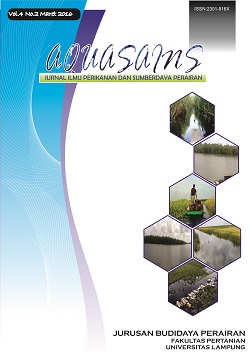THE STUDY OF BIOFLOC EFFECTIVENESS AS FEED ON TILAPIA (Oreochromis niloticus) AND SANGKURIANG CATFISH (Clarias gariepinus)
Abstract
Biofloc system is a technology in aquaculture which utilized waste mainly in form of anorganic nitrogen. The anorganic nitrogen will be converted into protein in the form of bacterial biomass by heterotrophic bacteria. The growth of heterotrophic bacteria is stimulated by the addition of a carbon source. This research aimed were to study the absolute growth, daily growth rate, specific growth rate and survival rate of tilapia and sangkuriang catfish which fed on biofloc. The research used Completely Randomized Design (CRD) which consisted of two treatments and four replication. The study lasted for 40 days, with the frequency of feeding biofloc was three times a day ie morning, afternoon and evening. Growth sampling was done every 10 days, observation of water quality every 8 days, and ammonia test was done at the beginning, middle and end of research. The results showed that tilapia which fed on biofloc have absolute growth, daily growth rate, specific growth rate, and survival rate better than those of sangkuriang catfish.
Downloads
Downloads
Published
How to Cite
Issue
Section
License
License for Authors
Authors who publish with this journal agree to the following terms:
- Authors retain copyright and grant the journal right of first publication with the work simultaneously licensed under a Creative Commons Attribution License that allows others to share the work with an acknowledgement of the work's authorship and initial publication in this journal.
- Authors are able to enter into separate, additional contractual arrangements for the non-exclusive distribution of the journal's published version of the work (e.g., post it to an institutional repository or publish it in a book), with an acknowledgement of its initial publication in this journal.
- When the article is accepted for publication, its copyright is transferred to Aquasains Journal. The copyright transfer convers the exclusive right to reproduce and distribute the article, including offprint, translation, photographic reproduction, microfilm, electronic material, (offline or online) or any other reproduction of similar nature.
- Authors are permitted and encouraged to post their work online (e.g., in institutional repositories or on their website) prior to and during the submission process, as it can lead to productive exchanges, as well as earlier and greater citation of published work (See The Effect of Open Access).
- The Author warrant that this article is original and that the author has full power to publish. The author sign for and accepts responsibility for releasing this material on behalf os any and all-author. If the article based on or part os student’s thesis, the student needs to sign as his/her agreement that his/her works is going published.
License for Regular Users
Other regular users who want to cite, distribute, remix, tweak, and build upon author’s works, even for commercial purposes, should acknowledge the work’s authorship and initial publication in this journal, licensed under a Creative Commons Attribution License.
This license lets others distribute, remix, tweak, and build upon your work, even commercially, as long as they credit you for the original creation.
This work is licensed under a Creative Commons Attribution 4.0 International License.Copyright Transfer Statement can be downloaded here


.png)









